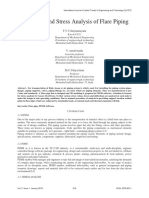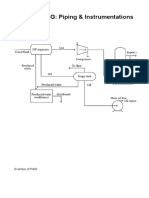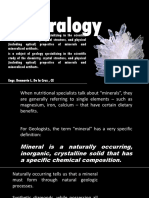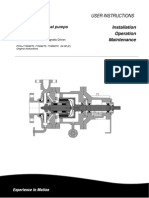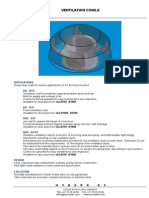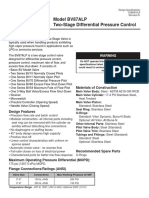Piping
Piping
Uploaded by
Dinesh Kumar JdCopyright:
Available Formats
Piping
Piping
Uploaded by
Dinesh Kumar JdOriginal Description:
Original Title
Copyright
Available Formats
Share this document
Did you find this document useful?
Is this content inappropriate?
Copyright:
Available Formats
Piping
Piping
Uploaded by
Dinesh Kumar JdCopyright:
Available Formats
Power Plant Fundamental
Piping System
Piping System - What is that?
O Concept - Layout Development
O Piping Components & their access requirement.
O Straight length requirements.
O Orientation of various tapings, components, etc.
O Piping Drains & Vents
O Insulation.
O Material & Sizing, PDT/VDT selection.
O Critical piping system consideration.
O Pipe Stress Analysis.
OO Pipe Supports
OO Special Considerations
OO Piping Designers Input & Output GET-DET Training Prog.,2003-Somnath Kundu
1
Let us first Discuss about WHAT IS PIPE!
It is a Tubular item made of metal,
plastic, glass etc. meant for conveying
Liquid, Gas or any thing that flows.
It is a very important component for any
industrial plant. And its engineering plays
a major part in overall engineering of a
Plant.
In next few pages we shall try to
familiarize about pipe and its
components.
Now we will try to understand step
by step how a piping system is
formed based on the requirements
We shall start with a plane white
sheet
This is the plane white
sheet we start with
Let us start drawing a
simple piping system
In any plant various fluids flow through pipes
from one end to other.
Now let us start with a plant where we see three
tanks.
Tank-1, Tank-2 and Tank-3
We have to transfer the content of Tank no. 1 to
the other two tanks.
We will need to connect pipes to transfer the
fluids from Tank-1 to Tank-2 and Tank-3
LET US BRING THE PIPES.
We have just brought the pipes, now we
need to solve some more problems.
Pipes are all straight pieces.
We need some
branch
connections
We need some bend
connections
To solve these
problems we need the
pipe components,
which are called
PIPE FITTINGS
These are the pipe fittings,
There are various types of fittings for various
purposes, some common types are -
Elbows/Bends, Tees/Branches,
Reducers/Expanders, Couplings, Olets, etc.
Anyway, the pipes and
fittings are in place, but the
ends are yet to be joined with
the Tank nozzles.
We now have to complete the
end connections.
These, in piping term, we call
TERMINAL CONNECTIONS.
These are flanged joints
This is a welded joint
So far this is a nice arrangement.
But there is no control over the flow from Tank-1
to other tanks.
We need some arrangement to stop the
flow if needed
To control the flow in a pipe line we
need to fit a special component.
That is called - VALVE
There are many types of valves, categorized
based on their construction and functionality,
Those are - Gate, Globe, Check, Butterfly, etc.
Other than valves another important
line component of pipe line is a filter,
which cleans out derbies from the
flowing fluid. This is called a
STRAINER
Here we see a more or less functional piping
system, with valves and strainer installed.
Let us now investigate some aspects of pipe
flexibility.
If this tank nozzle
expands, when
the tank is hot.
In such case we need to fit a flexible
pipe component at that location,
which is called an EXPANSION
JOINT
When some fluid is flowing in a pipe we may
also like know the parameters like, pressure,
temperature, flow rate etc. of the fluid.
To know these information we need
to install INSTRUMENTS in the
pipeline.
There are various types instruments to measure various
parameters. Also there are specific criteria for installation
of various pipe line instruments.
Next we shall look
into how to
SUPPORT the
pipe/and its
components.
Here are some of the pipe supporting arrangements.
There can be numerous variants. All depend on
piping designers preference and judgement.
Let us see some OTHER types of supports
We have just completed a pipe line design.
We shall rewind and check how it is really done in practice.
First the flow scheme is planned,
1) What, 2) From what point, 3) To which point
Pipe sizes are selected, pipe material and pipe wall thickness are selected.
Types of Valves are planned
Also the types of instruments required are planned
We represent the whole thing in a drawing which is called Piping and
Instrumentation Drawing, in short P&ID. For P&ID generation we use CADME
software.
By this time you have already come to know that while we prepare P&IDs in
CADME, we enter all the pipe lines system information in the drawing.
So the CADME drawing is an Intelligent drawing which under its surface carries all
the information about a pipe like, Pipe size, Flowing Fluid, etc.
Let us see a P&ID prepared in CADME
This is screen picture of
P&ID made by CADME
If we click on any line it will
show the Data embedded.
These are the embedded
data of this line
Let us look in to a simple P&ID for understanding of P&IDs.
This is part
P&ID for DM
water transfer
system
Click to see Iso
After the P&ID is ready we start the layout work.
Preferable
Not Preferable
We use PDWB software to route piping in the Plant virtual 3D space.
We call this as piping modeling or physical design.
While development of piping layout we have to consider the following
Piping from source to destination should be as short as possible with minimum
change in direction.
Should not hinder any normal passage way. Also should not encroach any
equipment maintenance space.
Here we carryout pipe routing / layout in Virtual 3D environment.
While carrying out pipe routing we also need to consider the following
Example of Straight length requirement for Flow Orifice
Valves, strainers, instruments on the pipe should be easily accessible.
If needed separate ACCESS PLATFORMS to be provided to facilitate these.
Desired location and orientation of valves / instruments and other pipe
components are to be checked and maintained, like some valves or strainers
can only be installed in horizontal position.
Specific requirements for instrument installation to be checked, like
temperature gauge can not be installed in pipe which is less than 4 inch in size.
Specific requirements of STRAIGHT LENGTH of pipe for some components to
be maintained, like for flow orifice we need to provide 15 times diameter
straight pipe length at upstream of orifice and 5 times diameter straight at down
stream of orifice.
= Also arrangement is kept in the
pipeline so that liquid can be
drained out if required.
= To achieve this a DRAIN
connection with Valve is provided
at the lowest point of the pipeline
= For Pipeline which shall carry liquid, we have to make sure that all air is allowed
to vent out of the line when the line is filled with liquid.
= To achieve this a VENT connection with Valve is provided at the top most point
of the pipeline.
Let us look
into typical
Vent and
Drain
arrangement
in a pipeline
= Pipes are also slopped
towards low points.
Pipe line Vents
and Drains
Let us have a look into a piping model done by PDWB
The Term PDWB stands for Piping Design Work Bench
This is a PDWB
model of Feed
water line along
with pumps and
other accessories
Let us look in to a Piping Isometric Drawing
From the Piping 3D Model we create the Piping Isometric drawings.
These piping isometric drawings are used to fabricate and erect the piping
at job site.
Let us look in to a Piping
Isometric Drawing
From the Piping 3D Model
we create the Piping Isometric
drawings.
These isometric drawings
are used to fabricate
and erect the piping
at job site.
This is part
Isometric for DM
water transfer
system
Click to see P&ID
INSULATION - When hot fluid flows through pipe then generally pipe is insulated.
There are two primary reasons for insulating the pipe carrying hot fluid.
Containing the heat inside the pipe. Insulation preserves the heat of the fluid. It
is called Hot Insulation
Personnel safety, so that people do not get burn injury by touching hot surface
of pipe. It is called Personnel Protection Insulation
Cold pipes are also insulated
Cold or chilled fluid carrying pipes are insulated to prevent heating of cold fluid
from outside. It is called Cold Insulation.
Some times cold pipes are insulated to prevent condensation of atmospheric
water vapor on pipe surface. It is called Anti-Sweat Insulation.
Other types of Insulation
When gas flows through pipes at high velocity, it creates noise. In such cases
pipes are insulated to reduce noise. It is called Acoustic Insulation.
Some times pipe and its content are heated from outside, by heat tracing
element. In that case pipe along with heat tracing element are insulated to
conserve the heat of the tracer. It is called Heat Tracing Insulation.
INSULATION MATERIAL - The insulating material should be bad conductor of heat.
There are two basic categories
1) Fibrous Material, which has large voids full of air between fibers - Cork, Glass Wool,
Mineral Wool, Organic Fibers. Note stagnant air is a bad conductor.
2) Cellular Material, which has closed void cells full or air - Calcium Silicate, Cellular
Glass (Foam Glass), Polyurethane Foam (PUF), Polystyrene (Thermocol), etc.
Some times Cast material like Cement Plaster or Plaster of Paris are also used.
INSULATION CLADDING - Insulation materials are generally soft or fragile. So the
outer surface of insulation are protected with Aluminum sheet or GI sheet
cladding.
Have a look at how
pipes are insulated,
and general
components of
insulation
Pipe Sizing Calculation - to select required pipe diameter based on velocity and pressure drop.
Find out
Flow volume
per second
Check Velocity
Allowable per
second
Calc. flow area
required and
Pipe size
Calc. Press.
Drop for that
Pipe size
Check Press.
Drop meets
Press. Budget
Pipe
Size
OK
YES
Increase
Pipe Size
NO
Pipe Material Selection - to select appropriate pipe material based on flowing fluid property.
Find out type
of Fluid
flowing
Check Pipe
life
Expectancy
Select suitable
Material per
practice (Note-1)
Check Mat.
Listed in
Design Code
Pipe
Material
OK
YES
See Note-
1
NO
Note-1 : Material is selected per past experience with cost in
mind and per material listed in design code. If material is
not listed in code we may select next suitable material
listed.
Find out
Fluid Temp.
& Pressure
Pipe Thickness Selection - to select appropriate pipe thickness based on flowing fluid property.
Select Mat.
& Diameter
as above
Decide on
Corrosion
allowance
Calc. Pipe
Thickness per
Code (Note-2)
Check if S&L
PDT matches
requirement
Selected
S&L PDT
for Project
YES
Create new
PDT for
Project
NO
Note-2 : S&L has a standardized sets of piping materials suitable for various
fluids and various service conditions, These are call - Piping Design
Table (PDT). If calculated pipe thickness do not match with standard
PDT, Project Specific PDT are created with PDTS software.
Find out
Fluid Temp.
& Pressure
Created
new PDT
for Project
Piping Design Table and Valve Design Table
S&L has standardized sets of pipe and valves grouped based of various application.
These sets are call Piping Design Table (PDT) for pipes and fittings, and Valve Design
Table (VDT) for valves.
These Tables with all their physical data are consolidated in the PLADES 2000
Database.
When we create piping 3D model by using PDWB software all Pipe and Valve data are
fetched from Database and automatically inserted in the piping model based on the
PDT selected.
While we select pipe or valve material for any intended service we try to select the best
suited S&L PDT already available in the Database.
If in any case we can not find a suitable match we have to create a new project specific
PDT or VDT.
This creation of PDT and VDT is done through PDTS software.
The created design table is reviewed and approved by authorized person.
As it is approved PLADES Database is updated, and the NEW PDT can be used in
generation of piping model.
This is an example of
project specific PDT
= In Power plant there are some piping which carries steam at high pressure and
temperature. And also there are piping which carries water at High pressure.
These pipes carries the main cycle steam and water of the steam power plant.
= These pipelines are call the CRITICAL PIPING.
= Very special care are taken for design of these piping.
= First the pipe material selection for such piping is very important as it has to
withstand the high pressure and may be also high temperature.
= As these pipes carry the main system fluid of the power plant, they are given
the right of way, and routed at beginning of the overall plant layout.
= Steam pipes run at very high temperature and the hot pipes expand. We have to
built in flexibility in the high temperature pipe routing so that the expansion
force is absorbed within the piping.
= Also there should be enough flexibility in these pipe routing so that high loads
are not transferred to the nozzles of Turbine or Pumps
= There are many recognized international codes which lay down guide lines and
mandatory requirements for design of such piping.
= The most important codes used by power plant piping engineers are
= ASME ANSI B31.1- Power Piping Code & IBR - the Indian Boiler Regulation
Pipe Stress Analysis
= We have already seen that some of the pipes are subjected to high pressure
and high temperature. Also pipes carry the load of the flowing fluid.
= We need to check and confirm the pipe is not going to fail with these loading.
= This process of checking the stress developed in the piping due to various
loading is called Pipe Stress Analysis/Flexibility analysis.
= In the process of Analysis we apply various postulated loading on the pipe and
find out the stress resulted from these loading.
= Then we check with governing codes if those stresses generated are
acceptable or not.
= We check support load & movement for various loading condition.
= We also check out the terminal point loading generated from pipe to the
equipment connected to the pipe. This loading are to be within acceptable
limits of the equipment suggested by the vendors.
= We also find out the pipe growth due to change in temperature and need to
keep the movement of pipe within acceptable limits.
= Pipe Stress Analysis is an Interactive and Iterative process. Each step is
checked
= If a check fails we have to go back, modify the layout and restart the analysis.
PIPE STRESS ANALYSIS
Inputs
=Geometric layout of Pipe
=Pipe supporting configuration
=Pipe Diameter and Thickness
=Pressure inside Pipe
=Cold and Hot temperatures of Pipe
=Weight of Pipe and insulation
=Weight of carrying Fluid
=Pipe material Property (Youngs Modulus,
Thermal Expansion Coefficient)
=Thrust on pipe due to blowing wind.
=Thrust on pipe due to earthquake
=Load of Snow on pipe
=Any transient loading like Steam Hammer
load
=Any other load on the piping
Tools we use
=PIPSYS - is an integrated pipe stress
analysis module of PLADES 2000
=CEASER - Commercial Piping analysis
software
=There are many other commercial software
available
Outputs
=Stress of the pipe at various loading
conditions
=Load at various supports and restrains.
=Movement of pipe at support locations
=Pipe terminal point loading.
Codes and Standards
=In general Power Plant Piping have to
comply stipulations of ASME ANSI B31.1
=In India Power cycle Piping to comply IBR
code requirements.
PIPSYS - the analysis module of PLADES 2000
It is a very powerful and flexible,
integrated stress analysis
module of PLADES 2000.
We work in PIPSYS in close
interaction with PDWB piping
Models.
Here are some of the Screen
views
Opening screen - It has a Nick
name - The Blue Screen
Geometry Plot screen - It
shows the model geometry
Types of Pipe Supports
In the beginning of this discussion we
talked about various types of pipe
supports. Here is some elaboration
=There are three general types
=Rigid type (no flexibility in the
direction of restrain)
=Spring type (Allows pipe
movement in direction of
loading)
=Dynamic Support (Degree of
restrain depends on acceleration
of load)
=There are two types of spring
support
=Variable load type, here support
load changes as the pipe moves.
=Constant load support, the load
remains constant within some
range of movement.
Constant Load Spring
Variable Spring
R
i
g
i
d
H
a
n
g
e
r
R
i
g
i
d
S
u
p
p
o
r
t
Dynamic Support,
Snubber
Rigid Support
Some Typical Pipe Support Drawings
Here is some typical Pipe support drawings showing some typical vendor supplied
component numbers. (See Support Catalogues in G drive g:\snl\techdocs)
Some Pipe Support Hardware DetaIs
Here is some typical Pipe support hardware Pictorial views
Some Special Considerations for Piping
When pipes are routed UNDER GROUND (Buried) following points to be kept in mind:
=Minimum pipe size to be routed under ground shall be not less than 1 inch.
=Avoid flange joint in U/G piping.
=Keep in mind if pipe leaks U/G, it will be difficult to detect, so avoid U/G routing of pipe
carrying hazardous fluid.
=Pipe to be laid below Frost Zone at areas where ambient temperature goes below freezing.
=U/G, Buried piping should be properly protected from corrosion.
=Pipe may be properly wrapped and coated to prevent corrosion.
=Or U/G piping be protected by using Cathodic protection.
Freeze Protection of outdoor Piping:
=In the areas where the ambient temperature goes below freezing there is a possibility that
the liquid content of pipe may freeze while the plant is under shut down.
=For similar case pipes are wrapped with heat tracing elements to maintain the content
temperature above freezing (around 4 deg. C) even when the ambient temp. is below
freezing.
=Electric Heat tracing is done by wrapping electric coil around pipe, which turns on as the
ambient temperature goes down. Pipes are insulated over the heat tracing coils.
=Heat tracing can also be done by winding Steam tubes around main pipes.
Piping Designers Input & Output
INPUTS TO PIPING DESIGNER
From Process
=What Fluid
=From Where to Where.
=Pressure, Temp. and Flow rate.
=Type of Flow control.
From Project
=What Project Specific
Requirements.
=Any existing facility or U/G work
From Mechanical
=Equipment Locations and
terminal parameters
From Civil
=Locations of foundations and
structures
From C&I
=Types of control and instrument
installation, tapping requirements
From Electrical
=Locations of electrical equipment,
cable tray and bus ducts
OUTPUT OF PIPING DESIGNER
To Process
=Final Pipe Size and Pressure
class
=Piping system Material
To Project
=Plant Interface drawing
=Interface with existing facility
To Mechanical
=Pipe layout both A/G and U/G
=Equipment terminal Loading
To Civil
=Locations of Pipe supports
=Pipe support loading to
foundations and structures
=Wall Penetrations
To C&I
=Locations instruments, control
valves on piping isometrics
To Electrical
=Pipe layouts both A/G and U/G to
match cable, duct bank routing
=Motor operated valve locations
Congratulations
!!!
We have come to the
End of Session for Piping
Hope you have gathered enough knowledge
to talk intelligently
on the subject of piping
and also start work on piping
You might also like
- Proposed Design of A 100 Ton Detergent Powder PlantDocument18 pagesProposed Design of A 100 Ton Detergent Powder PlantKrishna BelelaNo ratings yet
- Flare Line Stress AnalysisDocument7 pagesFlare Line Stress Analysisdhurjatibhutesh100% (1)
- How To Create Pipe ClassDocument6 pagesHow To Create Pipe ClassShyam Prasad K S100% (1)
- Aterial Specification & All Thickness CalculationDocument35 pagesAterial Specification & All Thickness CalculationPanjiUte100% (1)
- Pantech Pipe SCH ChartDocument1 pagePantech Pipe SCH ChartDinesh Kumar Jd100% (1)
- Site Analysis Checklist Kevin Lynch For VTH SemDocument3 pagesSite Analysis Checklist Kevin Lynch For VTH SemAdarshJacob100% (3)
- Pipe Stress Analysis Per ASME B31.3Document2 pagesPipe Stress Analysis Per ASME B31.3manickbatsaNo ratings yet
- Resistance Projection Welding Design, Calculation, Process AssuranceDocument20 pagesResistance Projection Welding Design, Calculation, Process AssuranceHemant80% (5)
- Piping Fundamentals:: M.N.RaghuDocument26 pagesPiping Fundamentals:: M.N.RaghuAlex Salvin100% (2)
- Mechanical Engineering Drawing: SR KaleDocument22 pagesMechanical Engineering Drawing: SR KaleAdnan RanaNo ratings yet
- PVE Piping Layout Presentation - Part 1Document68 pagesPVE Piping Layout Presentation - Part 1Nguyen Quang Nghia100% (1)
- Piping Stress Analysis Is The Most Important Activity in Piping DesignDocument10 pagesPiping Stress Analysis Is The Most Important Activity in Piping DesignShreesanth SreenivasanNo ratings yet
- PipingDocument13 pagesPipingrudiwoworNo ratings yet
- Kursus Piping - Proejct and Type of ProjectDocument26 pagesKursus Piping - Proejct and Type of ProjectMohamad Afiq Amiruddin ParnonNo ratings yet
- Piping InformationDocument201 pagesPiping Informationroyalcom100% (1)
- 347 Stainless Steel Class 2500 Piping SpecificationDocument3 pages347 Stainless Steel Class 2500 Piping SpecificationTrevor Kanode100% (1)
- Piping Designers Vessel OrientationDocument13 pagesPiping Designers Vessel Orientationkazishidota100% (1)
- Blowdown ValvesDocument13 pagesBlowdown ValvesShameer MajeedNo ratings yet
- Piping Stress Analysis TrainingDocument3 pagesPiping Stress Analysis TrainingGodwin100% (1)
- PVE Piping Layout Presentation - Part 2Document117 pagesPVE Piping Layout Presentation - Part 2Nguyen Quang Nghia100% (1)
- All Valve Steeltrade Technical DataDocument172 pagesAll Valve Steeltrade Technical DataQudri SaufiNo ratings yet
- 11.plant Layout PumpsDocument16 pages11.plant Layout Pumpshalder_kalyan9216100% (2)
- Accommodating Expansion in Piping SystemsDocument52 pagesAccommodating Expansion in Piping SystemsBeomHee LeeNo ratings yet
- Implementation of Expansion LoopsDocument13 pagesImplementation of Expansion LoopsSSS100% (1)
- Piping Codes & StandardsDocument12 pagesPiping Codes & StandardsAhmed Mansour100% (1)
- PIPING Engineering Interview Questions:-: Isolation, Regulation, Non-Return and Special PurposesDocument21 pagesPIPING Engineering Interview Questions:-: Isolation, Regulation, Non-Return and Special PurposesAdil KhawajaNo ratings yet
- PIPINGDocument6 pagesPIPINGMananNo ratings yet
- How Do You Select Piping Materials Part 2 1711297806Document39 pagesHow Do You Select Piping Materials Part 2 1711297806Umair AnsariNo ratings yet
- Introduction To Piping EngineeringDocument6 pagesIntroduction To Piping Engineeringchaitra100% (1)
- Thermal Expansion in Piping SystemsDocument55 pagesThermal Expansion in Piping SystemsDivyaSheth100% (1)
- Codes and Standards: Piping EngineeringDocument23 pagesCodes and Standards: Piping EngineeringAnnieMalik100% (3)
- 1722 Piping Drafting Instruc GuideDocument26 pages1722 Piping Drafting Instruc GuideRizwan Ashraf100% (3)
- Pump Piping and Valve InstallationDocument8 pagesPump Piping and Valve InstallationSingh100% (1)
- Piping FundamentalsDocument54 pagesPiping FundamentalsAveen100% (2)
- Piping Study Material - RoltaDocument49 pagesPiping Study Material - Roltahummingbird4u92% (12)
- Pump Layout & PipingDocument91 pagesPump Layout & Pipingrahult19100% (8)
- Piping QuizDocument20 pagesPiping QuizAlex CarreraNo ratings yet
- Buried Pipe - Neven DrobnjakDocument9 pagesBuried Pipe - Neven DrobnjakAnjani PrabhakarNo ratings yet
- Piping Materials FinalDocument29 pagesPiping Materials Finalvermaakash22No ratings yet
- Flare PipingDocument1 pageFlare Pipingsenthilask_81No ratings yet
- Design Practice Piping Around EquipmentDocument4 pagesDesign Practice Piping Around EquipmentdevNo ratings yet
- BASIC PIPING: Piping & Instrumentations Diagram: Example of PFDDocument9 pagesBASIC PIPING: Piping & Instrumentations Diagram: Example of PFDUps YamNo ratings yet
- 1 PipelineDocument69 pages1 PipelineEhab MohammedNo ratings yet
- Stainless Steel 304 FlangesDocument6 pagesStainless Steel 304 FlangesiSteelindiaNo ratings yet
- Richmond Stress NotesDocument110 pagesRichmond Stress Notesmsaad2100% (2)
- 60 +piping Engineering Interview QuestionsDocument8 pages60 +piping Engineering Interview QuestionsDENYSNo ratings yet
- An Overview Of: Plant Layout AND PipingDocument21 pagesAn Overview Of: Plant Layout AND Pipingpuru55980100% (2)
- Unlock-B31.3 Process Piping Course - 02 Metallic Pipe & Fitting SelectionDocument44 pagesUnlock-B31.3 Process Piping Course - 02 Metallic Pipe & Fitting SelectionProkopNo ratings yet
- Column Piping - Study Layout, Nozzle Orientation & Platforms RequirementsDocument23 pagesColumn Piping - Study Layout, Nozzle Orientation & Platforms Requirementsarfat nadaf100% (2)
- Piping Presentation L & TDocument61 pagesPiping Presentation L & TJitendra SurveNo ratings yet
- PlotplanDocument19 pagesPlotplanmsriref9333100% (2)
- Detailed Design and Engineering Deliverable ListDocument6 pagesDetailed Design and Engineering Deliverable ListShabaaz Mohammed AbdulNo ratings yet
- Piping - IntroductionDocument39 pagesPiping - Introductionsppatil100% (1)
- Piping Fundamentals - For Fresher Engineers: Piping System - What Is That?Document29 pagesPiping Fundamentals - For Fresher Engineers: Piping System - What Is That?Venkatesan Arunachalam100% (1)
- Piping BasicsDocument29 pagesPiping BasicsManoj Pratap SinghNo ratings yet
- Piping Fundamentals: No.14, 2nd Floor, M.G.road, Adyar, Chennai-41. Ph.:97106 54244, 044-6516 3033 WebsiteDocument31 pagesPiping Fundamentals: No.14, 2nd Floor, M.G.road, Adyar, Chennai-41. Ph.:97106 54244, 044-6516 3033 WebsitevuongNo ratings yet
- Basic PipingDocument80 pagesBasic PipingarunkumarNo ratings yet
- Basic Piping PPT-01Document29 pagesBasic Piping PPT-01Binu RajuNo ratings yet
- Basic PipingDocument80 pagesBasic PipingAbdul Wahab Ajiz100% (2)
- Nguyên tắc cơ bản về đường ống - Dành cho kỹ sư mớiDocument29 pagesNguyên tắc cơ bản về đường ống - Dành cho kỹ sư mớiMINH QUANG NGUYENNo ratings yet
- Fundamentals of Piping TechnologyDocument33 pagesFundamentals of Piping TechnologyEhab AbowardaNo ratings yet
- Piping Fundamentals: Piping System - What Is That?Document20 pagesPiping Fundamentals: Piping System - What Is That?narenicNo ratings yet
- Basic PipingDocument80 pagesBasic PipingmarasiganmarcoantonioNo ratings yet
- 02a Dasar-Dasar Sistem Perpipaan WovDocument102 pages02a Dasar-Dasar Sistem Perpipaan WovcurlychemNo ratings yet
- Dasar-Dasar Sistem PerpipaanDocument110 pagesDasar-Dasar Sistem PerpipaanWahidin Shekoski100% (1)
- E VF PDFDocument21 pagesE VF PDFDinesh Kumar JdNo ratings yet
- Xplore Orld Iping: The ofDocument3 pagesXplore Orld Iping: The ofDinesh Kumar JdNo ratings yet
- Paper ProcessDocument1 pagePaper ProcessWesley Apla-on MiguelNo ratings yet
- Unit ConversionDocument6 pagesUnit ConversionNavneet SinghNo ratings yet
- Xplore Orld Iping: The ofDocument2 pagesXplore Orld Iping: The ofDinesh Kumar JdNo ratings yet
- Cholamandal Artists' VillageDocument8 pagesCholamandal Artists' VillageDinesh Kumar Jd0% (1)
- Slide Rule MethodDocument1 pageSlide Rule MethodDinesh Kumar JdNo ratings yet
- Piping EngineeringManilalAMDocument62 pagesPiping EngineeringManilalAMDinesh Kumar JdNo ratings yet
- Improving Formulated Nitrogen, Phosphorus andDocument5 pagesImproving Formulated Nitrogen, Phosphorus andPKPPS KYAI PARAKNo ratings yet
- Recovery and Recrystallization Kinetics in AA1050 and AA3003 Aluminium AlloysDocument196 pagesRecovery and Recrystallization Kinetics in AA1050 and AA3003 Aluminium AlloysRavjManjunathNo ratings yet
- 08 Chapter 4Document8 pages08 Chapter 4Ali AliNo ratings yet
- Blend Dyeing (NEW BOOK) (Upload 28-06 - 2007)Document232 pagesBlend Dyeing (NEW BOOK) (Upload 28-06 - 2007)ibayraktar775208100% (1)
- Heating Catalogue 2019Document44 pagesHeating Catalogue 2019Zoran SimanicNo ratings yet
- Polyboard: Bitumen Impregnated Compressible Fibre Filler BoardDocument2 pagesPolyboard: Bitumen Impregnated Compressible Fibre Filler Boardmpandy1984No ratings yet
- Flavor ModulationDocument4 pagesFlavor Modulationcel012b1No ratings yet
- JEE Advanced Assign - Chem123Document80 pagesJEE Advanced Assign - Chem123aumoghNo ratings yet
- Emergency Medicines List (EML) : First EditionDocument42 pagesEmergency Medicines List (EML) : First EditionMalik TufailNo ratings yet
- ccc10-1 2018 222Document10 pagesccc10-1 2018 222Efari BahcevanNo ratings yet
- Copper ExtractionDocument16 pagesCopper ExtractionAndaradhi NararyaNo ratings yet
- Memory Upgrade For The Fanuc 16B (0010) Series CNC FROM Module InstallationDocument89 pagesMemory Upgrade For The Fanuc 16B (0010) Series CNC FROM Module InstallationAnkit Sabhaya100% (1)
- Astm C 642 90 Calidad Del ConcretoDocument3 pagesAstm C 642 90 Calidad Del ConcretoBayron Medina Ospina0% (1)
- CDU II Operating Manual PDFDocument562 pagesCDU II Operating Manual PDFMilind GaikwadNo ratings yet
- MineralogyDocument20 pagesMineralogyLaisa VittoNo ratings yet
- Ador Welding Cromoten D For c5 & f5 WeldingDocument1 pageAdor Welding Cromoten D For c5 & f5 WeldingShar MathewNo ratings yet
- Bread and Pastry Production: Prepared By: Cheena Gabriele C. CorralesDocument17 pagesBread and Pastry Production: Prepared By: Cheena Gabriele C. CorralesAngel Ericka Mae ArevaloNo ratings yet
- User Instructions: ERPN-M Centrifugal PumpsDocument37 pagesUser Instructions: ERPN-M Centrifugal Pumpstexwan_No ratings yet
- PEX - 75-Range-Plascoguard-Zinc-Phosphate-Epoxy-PrimerDocument2 pagesPEX - 75-Range-Plascoguard-Zinc-Phosphate-Epoxy-Primersarcozy922No ratings yet
- 21 CFR Part 50 - Protection of Human SubjectsDocument13 pages21 CFR Part 50 - Protection of Human Subjectsjubin4181No ratings yet
- Numerical Simulation of Sleeve Repair Welding On In-Service 16Mn Crude Oil PipelinesDocument5 pagesNumerical Simulation of Sleeve Repair Welding On In-Service 16Mn Crude Oil PipelinesjangdiniNo ratings yet
- Digester HeatingDocument5 pagesDigester HeatingAnonymous 0krfoNLGJNo ratings yet
- CHEMICAL EFFECTS OF ELECTRIC CURRENT GR 8Document6 pagesCHEMICAL EFFECTS OF ELECTRIC CURRENT GR 8rahma sajjadNo ratings yet
- NORM in SaudiDocument30 pagesNORM in SaudiRosa MendozaNo ratings yet
- Ventilation CowlsDocument12 pagesVentilation CowlsShahadatuliskandar RosliNo ratings yet
- Advanced Parallel Tandem Structures For Enhanced Organic Solar Cell Efficiencies PDFDocument12 pagesAdvanced Parallel Tandem Structures For Enhanced Organic Solar Cell Efficiencies PDFHuzaif RahimNo ratings yet
- Model BV87ALP Two-Stage Differential Pressure Control: DescriptionDocument2 pagesModel BV87ALP Two-Stage Differential Pressure Control: DescriptionadrianioantomaNo ratings yet
- S43 - Why The Multiple Stress Creep Recovery (MSCR) Test Should Be Implemented - LTC2013Document31 pagesS43 - Why The Multiple Stress Creep Recovery (MSCR) Test Should Be Implemented - LTC2013walaywanNo ratings yet

